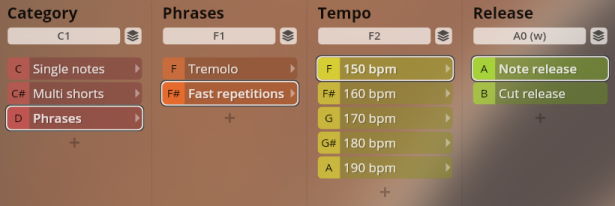SYNCHRON-ized Solo Strings Con Sordino
Introduction
Welcome to the Vienna Symphonic Library’s series of Synchron Instruments! This collection of two solo violins, viola, cello, and double bass is based on our Collection VI Solo Strings II. It offers a completely overhauled sample database optimized for the Vienna Synchron Player. Our goal was to improve each instrument’s playability and realism even more, which we achieved by enhancing the sample recordings as well as by utilizing the Synchron Player’s unique features.
For creating SYNCHRON-ized Solo Strings Sordino, our sound editors went back to the raw, unprocessed sample data of the original recordings, which were completely re-edited and re-mastered in order to achieve an all-new, modern string sound that excels in terms of aesthetics, playability and realism, and that is optimized for use alongside the Synchron Series instruments.
Mixer Presets
For SYNCHRON-ized Solo Strings Sordino, our software developers added a specifically designed convolution reverb derived from Vienna MIR Pro ta the Synchron Player, featuring the outstanding and unique ambience of the 540 m2 (5,813 sq.ft.) main hall of Synchron Stage Vienna. The perfectly engineered reverberation and placement presets combine customized impulse responses with expertly crafted reverb settings for each group of the ensemble. By adding the ambience of Synchron Stage Vienna’s Stage A to the dry samples in real-time, SYNCHRON-ized Solo Strings Sordino perfectly blend with any other product of our Synchron Series.
For each player, there are several Mixer Presets for solo and orchestral performances that depict different recording situations: Close, Classic, Distant, as well as settings without convolution but short and long reverb. In the solo Mixer Presets, you can also select the position of your players (left, center, right).
About Presets
Each instrument offers basic and full Presets. The basic Presets take up less RAM and are a bit easier to navigate because of their simplified structure with a maximum of three dimensions, while the full Presets encompass up to seven dimensions and give you access to the instruments’ entire wealth of articulations. If you would opt for using the basic Preset but find that you cannot do without certain Articulations not included therein, you will find empty “Custom” slots available into which you can load your desired patches. SYNCHRON-ized Solo Strings Sordino has a few more custom slots than you may deem necessary for reasons of consistency with SYNCHRON-ized Solo Strings (senza sordino). If you own both SYNCHRON-ized Solo Strings and SYNCHRON-ized Solo Strings Sordino, there also are merged Basic and Full Presets, which allow you to switch quickly between senza sordino and con sordino articulations.
Senza/con sordino keyswitch: A0/B0 resp. A5/B5.

Opening a merged Preset when SYNCHRON-ized Solo Strings or the respective senza sordino instrument are not installed or their path not entered in the Synchron Player’s database will show the missing articulations crossed out.

Important
Please note that the Expression Maps for Cubase and Dorico, as well as the Sibelius Sound Set for SYNCHRON-ized Solo Strings Sordino are configured for the instruments’ Basic Presets.
Velocity XFade Presets
The library offers three basic Preset types for every instrument in their respective folders, marked “VelXF sus - MOD”, “VelXF - MOD”, and “Velocity”. In “VelXF sus” Presets, velocity crossfading with the Modwheel (MIDI CC1) is only activated for long notes, while the dynamics of short notes are controlled by keystroke velocity, thus facilitating phrasing. “VelXF” Presets have velocity crossfading activated for all articulations, while in plain “Velocity” Presets, note volume is controlled by keystroke velocity just like a piano. Global velocity crossfading can be enabled or disabled by clicking its on/off symbol in the Synchron Player's Perform tab.
About Patches
Patches can be used to build your own custom Presets and thus adapt the Library to your specific requirements. For more information on how to do this, please refer to the Vienna Synchron Player software manual.
About Pitch
For designating pitch, the Vienna Symphonic Library uses International Pitch Notation (IPN), which was agreed upon internationally under the auspices of the Acoustical Society of America. In this system the international standard of A=440 Hz is called A4 and middle C is C4. All pitches are written as capital letters, their respective octave being indicated by a number next to it. The lowest C on the piano is C1 (the A below that is A0), etc.
The Synchron Player software allows you to set middle C to C3, C4, or C5 according to your preference. Selecting another setting than C4 will of course also change the play ranges and keyswitches accordingly.
Basic Presets
The Patches of the basic Presets are organized according to basic playing style or Articulation, e.g., short notes or dynamics. These slots may again contain subtypes (spiccato, staccato, …), with further options if available.
Articulations are disabled by default. Enabling an Articulation means that all the Types contained will be activated, too, so if you happen to be short of RAM it is advisable only to activate what you really need (you can always add more Types later).
Keyswitches and controllers
By default the keyswitches for Articulations are mapped starting with C1 (for Middle C = C4) for violin, viola, and cello, and C5 to G#5 for double bass. For the available Types, the keyswitches start from C2 for violin and viola, and from C7 for cello and bass.
Additional options within Articulations or Types are offered by the Dimension Controllers. The controller function is indicated by the respective caption, as of course it may take on different tasks as needed.
Ranges
The maximum play ranges of the instruments are:
- Violin 1 G3–A#7
- Violin 2 G3–G7
- Viola C3–G#6
- Violoncello 1 C2–F6
- Violoncello 2 C2–D6
- Double bass B0–G4
These may be less depending on articulation (e.g., harmonics).
Violin 1, Viola, Violoncello 1, Double bass
Short notes
Spiccato, staccato, short détaché, long détaché, and legato repetitive notes.
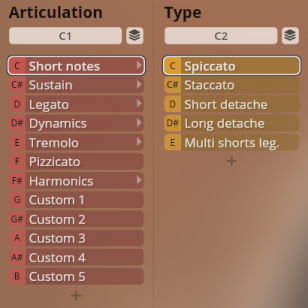
Long notes
Sustained notes without, with normal and progressive vibrato, and decreasing vibrato, and a crossfading option between no vibrato and vibrato. For consistency with SYNCHRON-ized Solo Strings (senza sordino), there is a copy of the vibrato patch instead of espressivo.
- Vibrato XFade control: Dim.Ctrl/A (CC3)
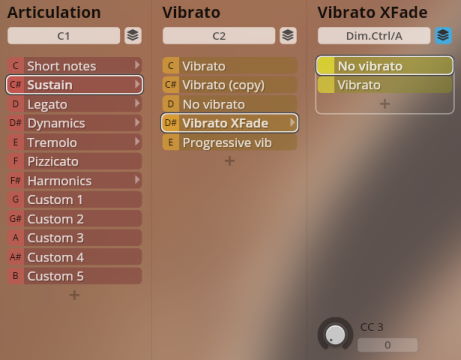
Legato
Auto-speed legato changing between regular legato and performance trills according to playing speed, as well as legato with progressive vibrato, portamento, and performance marcato.
- Auto-speed control: Dim.Ctrl/C (playing speed)
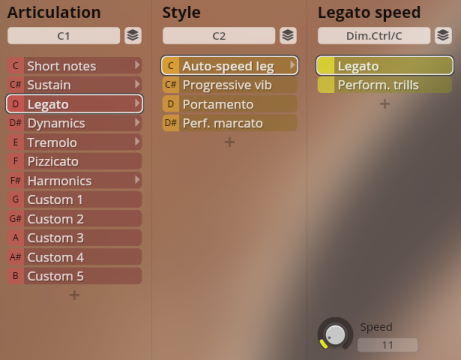
Dynamics
Sforzato, fortepiano, and sforzatissimo.
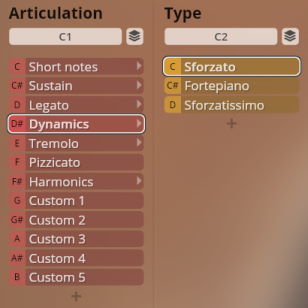
Tremolo and Trills
Tremolo regular and with sustain crossfading option.
- Sustain/tremolo XFade control: Dim.Ctrl/A (CC3)
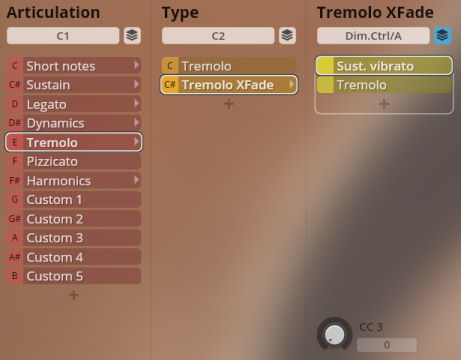
Pizzicato
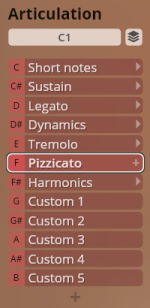
Harmonics
Harmonics, staccato and sustained.
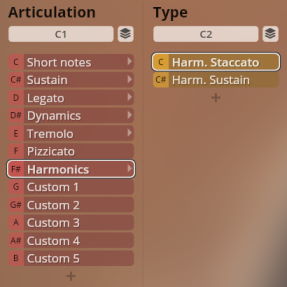
Full Presets
The Full Presets comprise all the available Articulations of the respective instrument. Naturally, these Presets take up more RAM than their Basic counterparts.
Keyswitches and controllers
The keyswitches for category (Single notes, Multi shorts, etc.) are mapped starting with C1 (for Middle C = C4) for violin, viola, and cello, and C6 for double bass. Within these categories, subdivisions such as type of single notes are controlled by keyswitches starting from F1/F6. Additional options within Articulations or Types are offered by the Dimension Controllers, which may be keyswitches or MIDI controllers. The controller function is indicated by the respective caption, as of course it may take on different tasks as needed.
Single notes
Short notes
Performance spiccato, staccato, short and long détaché.
- Articulation keys: from C2/C7.
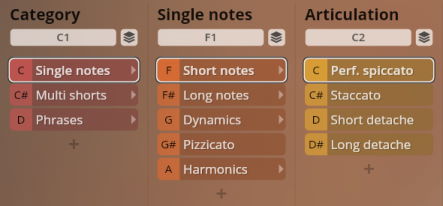
Long notes
Sustain, legato, portamento, and performance marcato.
Sustain
Sustained notes without, with normal and progressive vibrato, and a vibrato/no vibrato crossfading option.
- Vibrato selection: Dim.Ctrl/A (CC3).
- Vibrato XFade control: Dim.Ctrl/B (CC20).
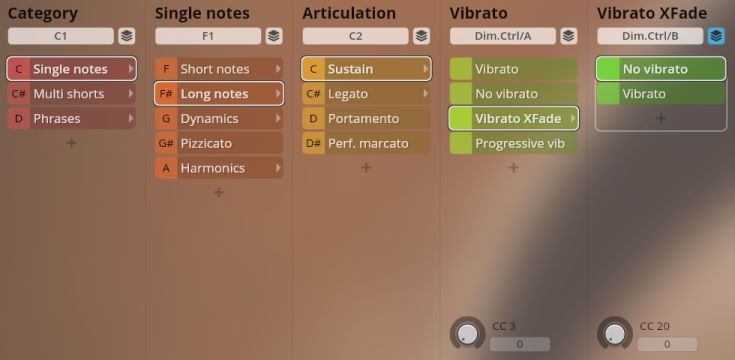
Legato
Legato without, with normal and progressive vibrato as well as a vibrato/no vibrato crossfading option, performance trills, and a legato/trill auto-speed option.
- Legato type keys: white keys from E2/E7.
- Vibrato selection: Dim.Ctrl/A (CC3).
- Vibrato XFade control: Dim.Ctrl/B (CC20).
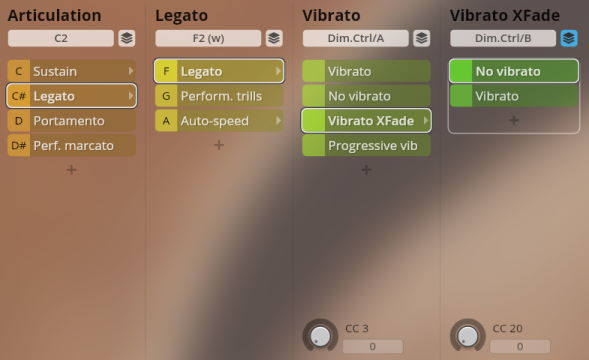
Auto-speed
Speed-controlled switching between legato and performance trills.
- Auto-speed control: Dim.Ctrl/C (playing speed).
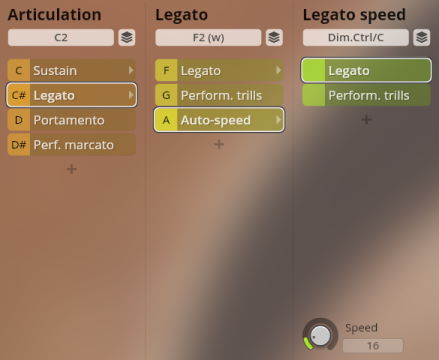
Dynamics
Accents, soft and strong dynamics, and piano-forte-piano.
- Accent/length keys: from F2/F7.
Accents
Sforzato, fortepiano, and sforzatissimo, as well as sforzato and fortepiano with subsequent crescendo.
Regular
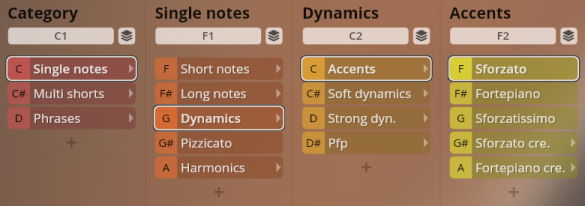
Crescendo
Sforzato and fortepiano layered with crescendo.
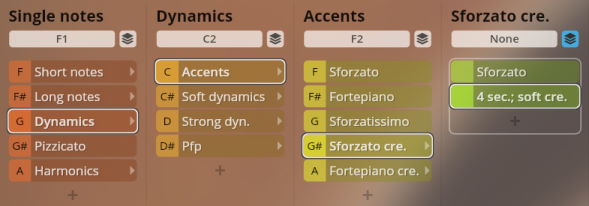
Soft/strong dynamics
Soft and strong crescendo and diminuendo, 2/3/4 sec.
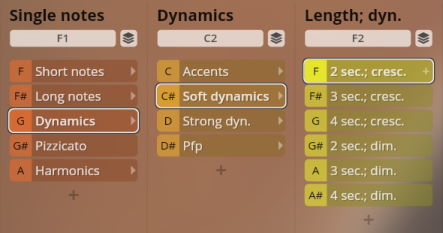
Pfp
Piano-forte-piano, 2/4/6 sec.
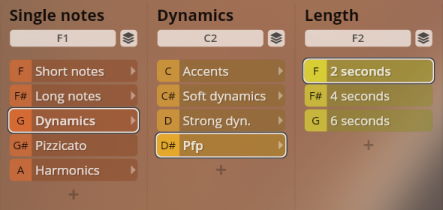
Pizzicato
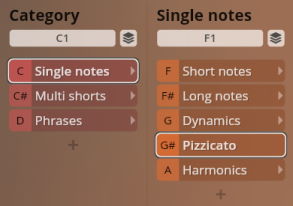
Harmonics
Harmonics, sustained and staccato.
- Note length keys: F2/G2 resp. F7/G7.
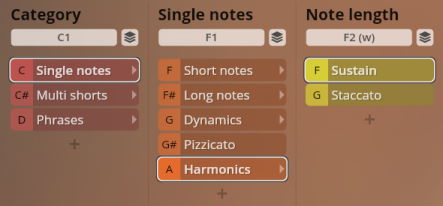
Multi shorts
Repetitions legato, portato, staccato, and spiccato, regular. Crescendo repetitions, with a dynamic layer option for velocity control. Legato crescendo has 5 repetitions/dynamic layers, the other speeds 9.
- Repetition speed keys: white keys from C2/C7.
- Regular/dynamic keys: from A2/A7.
- Dynamic layer switch: Dim.Ctrl/A (CC3).
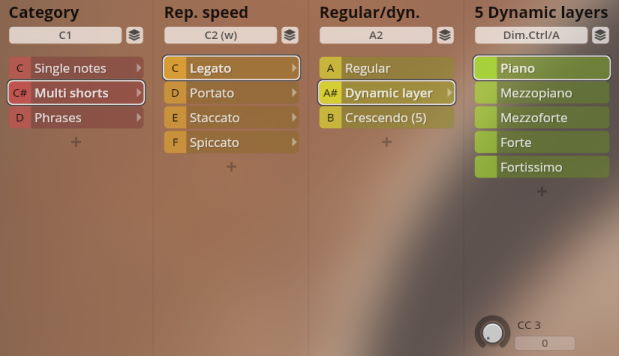
Phrases
Tremolo and fast repetitions.
- Phrase keys: from F1/F7.
Tremolo
Tremolo regular.
- Regular/dynamics keys: from C2/C7.
Regular tremolo
- Tremolo with regular attack, and fast attack with normal and cut release.
- Attack keys: from A0/A5.

Tremolo Xfade
- Crossfading option between vibrato sustain and tremolo.
- XFade control: Dim.Ctrl/A (CC3).
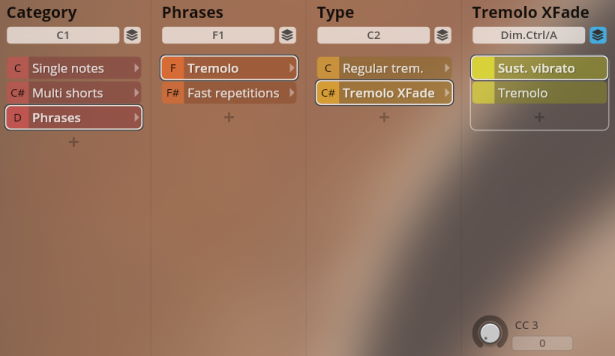
Fast repetitions
Short note repetitions at speeds from 150 to 190 BPM, with note and cut release.
- Tempo keys: from F2/C7.
- Note/cut release keys: A0/B0 resp. A5/B5.
